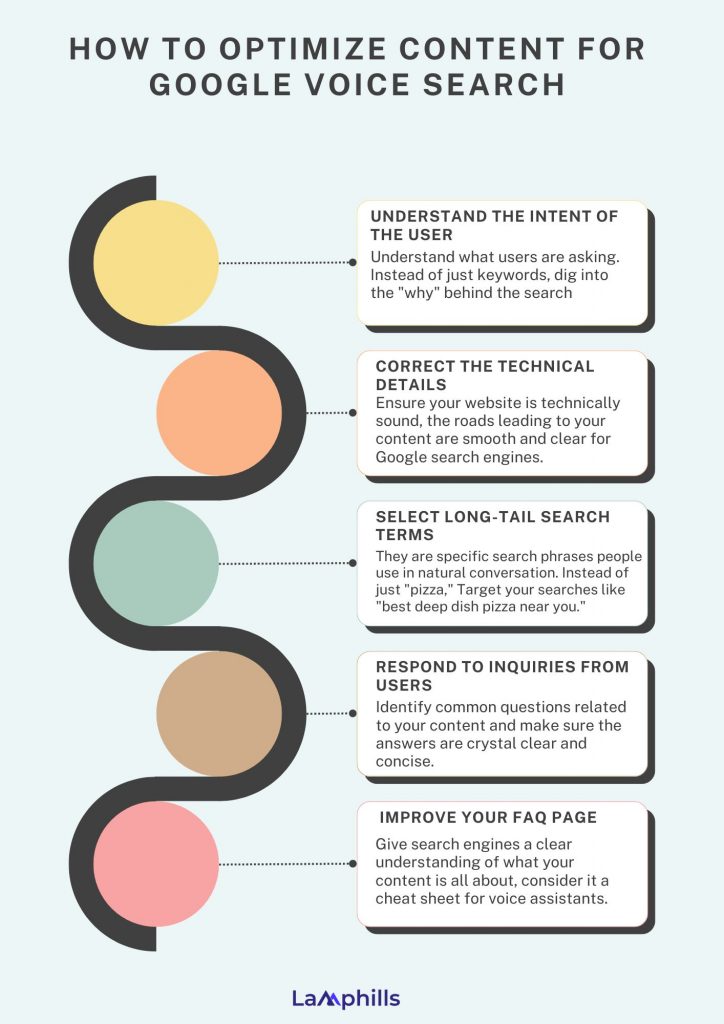Let’s talk about the next big wave in digital marketing: voice search optimization, or VSO for short. Remember those days of typing keywords into a search bar? We’re moving into a world of asking questions out loud, and virtual assistants like Siri and Alexa are leading the charge.
This means people are searching for information differently, and if you want your website to be seen, you need to adapt. VSO is all about making sure your content ranks well in these voice searches. But it’s not just about throwing keywords around anymore; there is more. So in this article, we’ll discuss the main distinctions between text and voice searches, why natural language matters more than ever, and how to optimize for those longer, more conversational questions people are asking.
Key points
- Voice Search Optimization (VSO) is all about making sure my website pops up when people use voice assistants like Siri or Alexa to search.
- Voice SEO helps search engines understand what kind of questions users ask naturally, with keywords and phrases.
- People love voice search because it’s fast and hands-free. They can ask questions while multitasking, like folding laundry or driving.
- To boost my company’s earnings using the power of Google Voice search, I focus on ranking within the top three search results.
- Search engines love websites that cater to voice search because it shows the content is relevant and user-friendly.
Lamphills Voice Search Optimization Checklist
Voice Search Optimization
Recently, I’ve been researching deeper into the field of voice search optimization (VSO), and it’s been a fascinating experience. It’s all about ensuring that one of the platforms I also work for pops up when you use voice assistants like Siri or Alexa to search. In other words, I want to be the answer when someone asks a question.
There are tons of situations where people do not like to type, and here’s one: When they need to ask questions in full sentences, like “What’s the best pizza place near me?” So, I need to optimize my content for this conversational style. That means using natural language throughout my website, ditching the short keywords I might use for text searches, and focusing on those longer, question-based phrases.
Think of it like this: if someone were to walk up to me and ask a question, I want my website to be like my well-rehearsed answer, I need to be ready to deliver the info clearly and concisely. Short, sweet, and to the point is key here. Search engines love websites that can answer questions quickly, so I sprinkle those FAQs throughout my content to make sure I’m hitting all the important points.
VSO isn’t just about the content, though. Since most voice searches happen on mobiles, I have to make sure my website is mobile-friendly. Fast loading times and easy navigation are crucial for a good user experience. Local SEO is also a big player. For example, if someone asks for “the best pizza place,” I want them to find me because I’ve optimized my site for local searches.
It’s a bit of a balancing act, but by focusing on natural language, user-friendly mobile experience, and local SEO, I can increase my chances of becoming the go-to answer for those voice search queries. And that translates to more people finding my website, which is pretty much the holy grail of any online game!
Why Is Voice Search Optimization Important?
Voice search optimization is becoming crucial. Imagine you’re cooking dinner covered in flour and need to find a recipe for that fancy dessert you saw on TV. Typing is a mess, so you whip out your phone and ask it, “Hey Google, show me a quick and easy creme brulee recipe.” That’s the power of voice search, and it’s changing how people find information. Here’s why I’m optimizing my website for it:
#1. A Goldmine for Reaching New Customers
Billions of searches happen every month by voice, and that number is only going up. If my bakery isn’t showing up in those searches, I’m missing out on a huge chunk of potential customers who might be asking for “the best cupcakes near me.”
#2. Convenience Is the Key.
People love voice search because it’s fast and hands-free. They can ask questions while multitasking, like folding laundry or driving. By optimizing my content for natural language questions, I can ensure my bakery is the answer they hear when they ask, “Where can I find fresh bread this evening?”
#3. Boosts My Overall SEO.
Search engines love websites catering to voice search because they show the content is relevant and user-friendly. Optimizing for voice search often overlaps with good SEO practices anyway, like using clear language and building high-quality content. So, by making my website voice search friendly, I’m not only reaching new customers but also giving my website a better chance of ranking higher in regular searches.
How Does Voice Search Work?
I pick up my phone and ask it, “Hey, what’s the capital of France?” Easy, right? But behind the scenes, there’s a whole conversation happening between my voice and the device. Here’s how it works:
#1. Speech Recognition:
When I talk, my voice hits the microphone, and it’s like a mini-concert – a mix of sound waves. This jumble includes my voice, and maybe some background noise, like the whirring of my fan.
#2. Audio Recording and Enhancement:
My device acts like a sound engineer. It records the entire concert, but focuses on my voice, filtering out the fan noise. It might even boost the volume to ensure everything’s clear.
#3. Analyzing Sound Patterns:
Now things get interesting. The device takes my voice recording and breaks it into tiny pieces, like musical notes. It analyzes these snippets, looking for patterns – the highs and lows that differentiate sounds like “b” and “p.”
#4. Deciphering Speech:
This is where the magic happens. The device uses its knowledge of these sound patterns and a whole lot of clever programming to translate my voice recording into actual words. It considers things like grammar and common phrases to make its best guess at what I’m saying. Believe it or not, it’s like having a tiny voice translator in my device!
Google Voice Search Optimization
I focus on ranking within the top three search results to boost my company’s earnings using the power of Google Voice search. These top spots capture 80% of Google Assistant’s voice search responses, making them crucial for influencing buyer decisions and increasing my business’s visibility.
What is Google Voice Search Optimization?
Google voice search optimization, or VSEO for short, is all about making sure my website is the one virtual assistants like Google Assistant or Alexa point users to when they ask questions with their voice. VSEO involves a two-pronged attack: optimizing my site’s content and ensuring the technical aspects are tip-top.

How To Optimize Content For Google Voice Search
It’s all about making sure your content gets noticed by the growing crowd using voice assistants. Here’s how I’ve been getting my content in the spotlight.
#1. Understand the Intent of the User
I start by understanding what users are asking. Instead of just keywords, I dig into the “why” behind the search. Are they looking for instructions on how to bake a cake, or are they curious about the history of dessert? This user intent helps me tailor my content to provide the answers they crave.
#2. Correct the Technical Details
I ensure my website is technically sound. Think of it as making sure the roads leading to my content are smooth and clear for Google search engines. Fast loading times and mobile-friendliness are key here. Nobody wants to wait for a website to load, especially not a voice assistant on a phone!
#3. Select Long-Tail Search Terms
Long-tail keywords are my new best friends. These are those more specific search phrases people use in natural conversation. Instead of just “Burger,” I target searches like “best deep dish pizza near me.” This helps me snag users who are further along in the buying journey, and ready to take action.
#4. Respond to Inquiries From Users
Speaking of taking action, answering user questions directly is a surefire way to win. I identify common questions related to my content and make sure the answers are crystal clear and concise. Imagine a voice assistant reading out the answer – short, sweet, and straight to the point.
#5. Improve My FAQ Page
For voice search questions, this is an absolute treasure! By anticipating user questions and providing detailed answers, I’m giving search engines a clear understanding of what my content is all about. Consider it as a cheat sheet for voice assistants, ensuring they deliver the right information to users.
By following these steps, I’ve seen a jump in traffic from voice searches. It’s all about thinking the way people speak and making sure your content is the perfect answer to their questions. So, let’s get out there and optimize for those voice searches!
What Are the 5 Voice Search Platforms?
You might be surprised, but there are more ways to search by voice than you think! Besides talking to assistants like Google assistant on my phone or Alexa on that cool speaker at my friend’s house, I can also use voice search right on the Google search engine on my laptop. It’s handy for looking things up fast, especially when my hands are full. There are other assistants out there too, like Siri for iPhones and Cortana from Microsoft, but those are the main ones I see people using.
How Does Voice Search Affect SEO?
You wouldn’t believe how much voice search has blown up local SEO! People are constantly asking their phones for things like “best restaurants near me” or “urgent care clinics open now.” If I want my business to be the answer they hear, I have to focus on local SEO. That means making sure Google knows exactly where I am and what I offer, so it can recommend me when someone asks a question. It’s all about becoming the local hero in voice search!
What Is Google’s Voice Search Called?
I hear you saying “Forget typing, let me talk!” Well, Google’s got you covered with their voice search feature, also known as Search by Voice. It’s like having a mini search assistant in your pocket. Just open the Google app or website, tap the microphone icon, and ask away. Whether you’re looking for something specific or browsing the web, you can ditch the keyboard and use your voice for a hands-free search experience.
Related Articles
- 20 BEST MEDIA MONITORING TOOLS IN 2024
- How to Do Social Media for Nonprofits (All You Need)
- 7 Effective PR Strategies & How to Create One in 2024 (+ Template)






